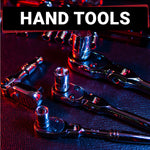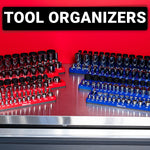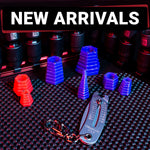A properly set torque wrench prevents stripped bolts, damaged parts, and safety hazards. Whether you're working on engine components, suspension systems, or other delicate machine parts, you’re only doing the job right if your wrench is correctly set.
We’ll walk you through the steps to set a click type torque wrench and use it effectively. We’ll also cover setting digital and dial torque wrenches so you can finish the job no matter your wrench type.
Step 1: Unlock the Handle
Click type torque wrenches feature a locking mechanism at the base of the handle, which prevents unintentional changes while in use. Before adjusting the torque setting, unlock the handle for smooth and accurate adjustments.
- Identify the lock: Look for a knurled (textured) knob or a pull-down collar at the bottom of the wrench handle.
- Twist or pull to unlock: Depending on the model, twist the knob counterclockwise or pull down the collar to disengage the lock.
- Make sure the handle is free to rotate: Once unlocked, the handle should rotate freely, so you can set the correct torque value without resistance.
Step 2: Locate Torque Measurements
Next, find and understand the torque scale. Torque wrenches typically feature a dual measurement system that displays values in foot-pounds (ft-lb) and Newton meters (Nm) to accommodate different specifications.
The scale is usually engraved on the wrench’s shaft and consists of evenly spaced increments representing torque values.
The handle might also feature a micro-adjustment scale that fine-tunes the torque setting. This scale helps set values between the larger increments on the main scale.
Locate the manufacturer-specified unit and measurement for the fastener before setting.
Step 3: Adjust the Torque Setting
Once you identify the correct torque value, rotate the handle and watch the main scale. As you turn, the indicator will move up or down the scale on the handle to align with the desired torque. If your wrench has a micro-adjustment scale, use it to fine-tune the setting to the exact specification required for your project.
For best results, verify that the zero line on the handle aligns with the desired torque value on the main scale.
Step 4: Lock the Handle
After setting the correct torque value, lock the handle. Most torque wrenches feature a locking mechanism at the base of the handle, typically in the form of a twist knob or a pull-down collar. Twist the locking knob clockwise until it is snug, or push the collar back into place if your wrench uses a pull-down design. Make sure the handle is firmly locked.
How To Set a Digital Torque Wrench
Digital torque wrenches are quick and easy to set. Unlike mechanical wrenches, digital models let you program the exact torque value with the push of a button. Follow these steps for accurate adjustments:
- Press the power button to activate the digital display.
- Choose between foot-pounds (ft-lb) or Newton-meters (Nm) based on your project’s requirements.
- Use the plus (+) and minus (-) buttons, number pad, or a dial to adjust the torque setting.
- Some models have a lock function to prevent accidental changes. Activate it if needed.
Once set, your digital wrench is ready to use. Apply torque as usual, and rely on the digital alerts to signal when you’ve reached the correct setting.
How To Set a Dial Torque Wrench
A dial torque wrench offers high precision by displaying the applied torque on a dial gauge. Unlike click-type wrenches, you don’t set the torque. Instead, tighten the fastener and monitor the dial until it reaches the desired torque.
Setting a Torque Wrench FAQ
What does the lowest setting do on a torque wrench?
The lowest setting removes tension from the internal spring when the wrench is not in use. Store a click-type wrench at this setting to reduce wear on the internal components and prevent drift in calibration. Digital and beam-type torque wrenches don’t require adjustments before storage.
How does a beam torque wrench measure torque?
Beam and split beam torque wrenches rely on a beam design where a pointer moves along an accurate scale as force is applied. Unlike click-type wrenches, it does not require a preset torque setting. The user monitors the scale and stops tightening when the pointer reaches the correct torque specifications.
Why use preset torque on a digital torque wrench?
Preset torque removes the need to check the scale. The user enters the exact torque values, and the wrench signals when the force is correct. Digital models use electronic sensors for precise readings. They’re faster and easier to use than manual wrenches with a mechanical scale but cost more.
Which direction should a torque wrench turn to tighten fasteners?
Most torque wrenches apply force in a clockwise direction, tightening fasteners with right-hand threads. Some models reverse for left-hand threads, but not all include this function. Check the wrench before use to prevent fastener damage, especially when working with specialized or reverse-threaded hardware.
What happens if a torque wrench stays at the lowest torque setting?
If you keep your click-type wrench at the lowest torque setting, you protect the internal spring. Leaving the wrench at a high setting causes the spring to weaken, which decreases accuracy. Beam and digital wrenches do not require this adjustment, as they function without a preloaded spring.
What is the difference between a socket wrench and a torque wrench?
A socket wrench (ratchet) turns fasteners without measuring force. A torque wrench applies a specific torque specification to prevent over-tightening or under-tightening. Unlike a common ratchet, which lacks accuracy, a torque wrench signals when the correct force has been applied, using a click, beep, or visual indicator.
How often should a torque wrench get calibrated?
Annual calibrations keep a torque wrench within its intended accuracy range. Heavy use or rough handling may necessitate sooner calibration. Wrenches exposed to drops or extreme conditions should be tested regularly.
What does a certificate of calibration confirm?
A certificate of calibration verifies that a wrench meets industry standards for accuracy. Testing follows strict procedures to ensure compliance with exact torque values. Professional users often require this document to prove tool reliability, especially in mechanical, automotive, and aerospace applications where incorrect torque can cause failures.
What additional features improve torque wrench accuracy?
Electronic sensors, an audible signal, and a high-contrast accurate scale improve precision. Some models include a digital readout for exact-level confirmation. Wrenches with memory settings save time on repetitive tasks. A smooth ratcheting mechanism reduces resistance to keep torque readings consistent across multiple fasteners.
Can normal bolts break from too much torque?
Over-tightening can exceed the maximum torque of a bolt or thread, causing fastener threads to stretch or shear and bolt heads to break. Using a wrench with accurate measurements prevents failures. Applying more force than necessary does not improve strength and usually weakens the connection.








